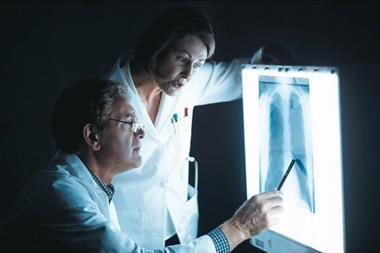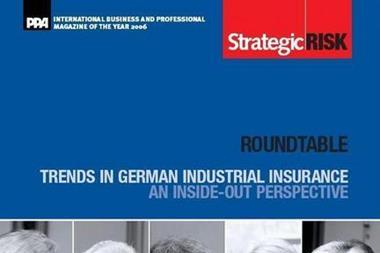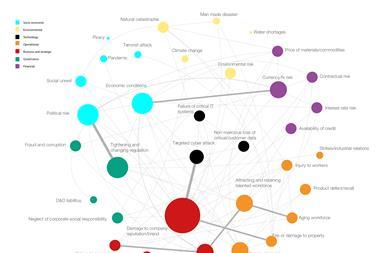Günter Dröse: If you look at Solvency II and Basel II, there is also the question of the financial conglomerates. That will be really interesting later with the way equity capital is allocated. The FSA has already promised that it will push for banks to give insurers in their groups as much capital as possible. How that can all be organised, that I regard as reading the tea leaves, although it is naturally presented as a mathematical model of high precision.
Edwin Meyer: For me, the question is always: why are we actually doing this? Why do we have Sarbanes-Oxley, Basel II, why are we going to get Solvency II? The reasons are clearly to be found in specific cases, Enron and others. They have led to investors’ trust in parts of the American economy being shaken. If I have a captive, when it is consolidated and if that is acceptable to the experts, is it also acceptable to those investors who read the annual report? We ought to say that there is an insurance company, but the aim of this company is actually a rather different one, and also in balance sheet terms, the influence of this company on the parent company is less. But is that really true? What would happen if we found no reinsurance for the captive, but have given the captive an environmental risk with a capacity of ?500m?
Herbert Fromme: Mr Allerdissen, you have just asked what the rating agencies have been doing up to now, if not that? One can find reinsurers and insurers who speak relatively positively about Solvency II. One reason for this is that they hope Solvency II will weaken the influence of the rating agencies. They are sick and tired of rating agencies.At some point in time, they are going to feel the same way about the supervisors. But for the time being they believe that Solvency II gives them a clean system that they themselves can calculate. Then they make a deal with the supervisory authority, and then they can forget the rating agencies – or so they hope. A second point. One interesting aspect of Solvency II will be that international diversification across EU borders will lead to less need for capital. A sensible insurer who wants to grow properly, will therefore have to grow outside his own country. That means that the number of insurers who have pan-European activities will increase. Do you welcome that?
Ralf Oelssner: The excitement among some insurers and reinsurers, to get away from these troublesome rating agencies at last, reminds me a bit of the Polish satirist Stanislaw Jerzy Lech. He said, now you have gone headfirst through the wall, what do you plan to do in the neighbouring cell? Whether things will now, through state supervision, be better than what we have had so far – I have my doubts.
Hans-Jürgen Allerdissen: Perhaps the effect on capital of the international diversification in Solvency II explains why we suddenly have in Germany so many new providers coming from abroad. However, I am afraid that this has not increased the number of potential leaders. This will take considerable time. And I can see an opposite trend, also triggered by Solvency II. Because we know that the capital support has to be higher where the volatility is greater. Our risks are naturally more volatile than those in a wider business. That means that if on the one hand the demand for capital drops because one goes outside the country, then I ask myself whether one then writes industrial insurance, of all things, with its high volatility which then has to be given greater support.
Herbert Fromme: In the years 2004–2006, industrial insurers in the whole of Europe or in the whole world earned more than at any other time in history. Their pockets are bulging. That has a positive effect on them, even if a flatter phase comes now. I do not think there will be any lack of capacity.
Günter Dröse: Every company which wants to receive a decent rating and the stamp of approval from the supervisory office, has to produce high profits as security for the company itself and for the capital market. I do not know how society can deal with this strange gap so that all companies can show 20% return on their equity capital. That means, if this is the consensus that the whole financial industry at some point will have been implemented in the whole world, and if the supervisory offices everywhere agree to that, then nobody has a right to complain if the insurance industry in future achieves high profits, over and above the three record years.
Ralf Oelssner: Anyone who wants to earn more than 5% has to take risks. I do not know whether that can be done in full measure under Solvency II.
Herbert Fromme: Exactly.
Ralf Oelssner: Mr Fromme has put the question, in the sense of the German poet Erich Kästner, of where is the positive side? What do we see as possible positive points in Solvency II? For me personally I draw a parallel between the Christian faith and the real-life situation of the church. The ideas of the faith are themselves good, but the practice, the institution, the mechanics – there we may have certain doubts. That is perhaps putting things a bit high, but the basic thought is clear. Of course securing adequate solvency for the carrier of our risk is important and we welcome it. We do not need to have a big discussion, but the side effects – here I am not quite so sure that absolutely everything is in the most elegant form and the most welcome form for the client.
Andreas Berger: I would like to make a point for Solvency II. Standard & Poor’s and other agencies found out early on that there is movement in the international industrial insurance market and a need for ratings. In the German market this started in 1997, when the first models appeared. The instruments which were available got more and more powerful, but they were only used by those companies which were internationally active, and by the brokers who assisted in choosing the companies. Now the following is happening. First and foremost, discipline in the companies is being secured. Solvency II will bring something even in the biggest companies, namely the link between that which can actually be achieved by the company, and that which is negotiated on the front line with the clients. We have got better here, and the market is doing that now as a whole. Automatically, companies for whom rating has not been a relevant instrument up to now will also adopt this way of doing business.
Günter Dröse: I see this slightly differently. According to what I know from the Bundesbank and BaFin, it has never been the aim to secure the existence of an individual company with these regulatory models Basel II and Solvency II. They have given the crystal clear explanation that if anyone goes under in competition, then he goes under, and it is not their job to secure the existence of an individual company. The aim is solely the systemic risk, to ensure that the collapse of one company does not mean the collapse of all. A single company can go under, why not? If we do not have that any longer, we should really start to say that all carpenter shops fall under a directive laying down that they have to make a profit, that each tyre manufacturer has to make a profit, and so on. Then the whole state is being regulated, then we have a planned economy. That cannot be our aim. The individual company must have a chance to be successful or unsuccessful.
Herbert Fromme: That does not work with insurers, definitely not. That is true of banks. With insurers, the regulators have specifically said they aim to prevent any individual insolvency, at least the continental Europeans.
Günter Dröse: Yes, the English are shouting loudest in favour of Solvency II.
Herbert Fromme: BaFin is afraid of nothing more than a failing insurer. That is the worst that could happen to them, and for this it accepts that competition is restricted in certain sectors, that is all the same to them.
Edwin Meyer: I certainly welcome the fact that, as a result of Solvency II, risk management processes are taking place within the insurance companies. We often have the problem, if we go into individual lines, particularly when they are not one of the top lines, then we ask ourselves the question, why is there still such a fluctuation in the setting of prices?
Herbert Fromme: Mr Meyer, if you as a client receive a first questionnaire from an insurer which has been drafted according to Solvency II, your support could perhaps weaken a bit.
Edwin Meyer: That could be. But I say that, as a practitioner of risk management I know that such rules as Solvency II do provide considerable internal support in process control, internal audits and so on. I expect success here from Solvency II. For me, it is really again and again a question of the price setting of the insurer. It can be arbitrary, although today it is more and more affected by global events. The question is, how can it be that a product cost up to 40% or 50% more a few months ago than it does now? Either somebody stated a wrong price then, or the price is wrong today. The banks have their Libor, and there one says just so many basic points higher and so many basic points lower. Even if the Libor itself fluctuates, there is at least some orientation.
Ralf Oelssner: Mr Meyer, I hope I never have to work in a situation where it can be said, that’s the right price. I love this insecurity, I love this volatility. To say that there is a right price, and that perhaps over a period of several years – for God’s sake. That is the work of the devil!
Edwin Meyer: But then why is it not the work of the devil in the banks?
Ralf Oelssner: I do not know. I don’t know anything about banks.
Reiner Hoffmann: Mr Oelssner, I can reassure you that there will certainly be no market price for risks, even in several years time. The problem is simply one of solvency. That costs money, and it is influenced not only through the risks, which are in any case very complex, but also through the degree of diversification. In addition: the models which we use as a market are so sensitive, and our demands are so high, that the aspect of chance is actually always included. This also explains why, apart from market processes, these prices for insurance or industrial insurance will always be volatile.
Ralf Oelssner: Yes, now I am reassured. I feel much better.
Wolfgang Faden: I wanted to look at the exciting question of whether growth strategies will change in connection with Solvency II. Allianz has again recognised the profitable growth aspect, following a self-ordered period of growth restraint, that is also true for industrial insurance, and we have also planned profitable growth for Germany. The real question is, whether it is still possible to grow in Germany in view of the fact that growth abroad will have a positive influence on capital needs because of diversification. When I take Allianz Global Corporate & Specialty, we have around ?1bn gross premium in Germany. If I were to say how much of that we lost on 1 January after renewals, without having made any mistakes, it sounds alarming. These are simply mechanisms which we cannot prevent. This is partly because of clients who carry more risks themselves and also due to company mergers. Industrial insurers can no longer operate at all without doing so internationally, because on the one hand industrial clients are active all over the world, and on the other hand the relatively saturated German market ultimately won’t produce the same growth as in the new emerging economies.
Herbert Fromme: We have just spoken about the three good years in industrial insurance. Why did you let the insurers get away with it, so that they earned so much? Mr Meyer, why did you pay so much for insurance?
Edwin Meyer: Yes of course, it is the same as with the weather. We always work from a basic value. In recent years we have clearly seen a reduction in premiums. The only answer I can give to the question of whether the premiums are still too high, is to say that at the time of signing our contracts we were happy with the price setting.
Herbert Fromme: Did the insurance industry try to intimidate you by using 11 September 2001?
Edwin Meyer: At that time I was on the insurance side myself. Things did in fact happen that had not previously been regarded as possible. For instance, it is an unimaginable scenario for our global economy that all aircraft should be grounded. In the risk management area, I had for the first time the impression that the world recognised the link between insurance and such risks. Obviously one does not want to have an 11 September for this to happen. The first result was the development on the stock exchanges. Before, more had been earned through the stock exchange than through underwriting, everybody believed they would still make profits with a combined ratio of 110%. That the insurance industry reacted in a knee-jerk fashion in 2001 to 2003 led to the situation that in 2005 in spite of Katrina, Wilma and Rita in the USA they finished up with $44bn profits, despite losses of $66bn from the storms.
Ralf Oelssner: I would like to follow up here. The answer cannot be so general. The markets differ considerably. If there are no storms, nothing happens in Bermuda. Then they are rolling in gold. If you then look at the lines where some of us are active. Of course we all were surprised in early 2001, to say the least, without letting it show. The market for property/casualty was then completely down the drain, the rates were so low they were beyond imagining. One can understand that insurers used the opportunity provided by 11 September to do some basic education. OK, we resisted this as strongly as we could. But it still came very heavily. Before 11 September I paid $19.5m for aviation insurance; from 1 October 2001 it was $120m. After such a steep rise you do not get back to the starting point in a few years. That cannot be done, as we all know. That only goes in a flattening-out process, one that is as steep as possible, but that does not happen from one day to the next. And we could have no better argument than to say: you have eaten your fill for three years, that is enough, now let us talk about rates.
Hans Jörg Schill: I think we were indeed intimidated in 2001, but that comes from our work as an airport operator. The airlines would have stayed grounded if they had not been able to prove cover they had beforehand. It would have been the same for us. At that time we had to accept a triple rise in price. In the last three years, from a narrow base, we have been able to negotiate the prices a little bit downwards. But you can never say what is the right price.
Hans-Jürgen Allerdissen: We did not experience the fluctuations quite so strongly. Certainly we moved with the market trend, we experienced the peaks and lows in the same way, whereby the trend now is downwards. I believe that this will continue. What we found much more annoying were the exclusions and limitations in cover.
Günter Dröse: We do not have typical industrial business. But we also have special risks. In the last 25 years, we did not really have any major price fluctuations in the fundamental insurance programmes. The exception is clearly the period
following the World Trade Center. Here we naturally also had a similar multiplication as in aviation. That flattened out. As far as the conditions are concerned, I agree with Mr Allerdissen, that is actually the only tool that the insurance industry had. When the industry sees that there is a specific accumulation,
or recently particular loss scenarios, then they exclude that from the cover.
Herbert Fromme: One of the reason why the prices rose as they did was the increase in reinsurance rates. Reinsurers had to raise their prices because they over-reached themselves in 1997 to 2001 with liability business in the USA. They provided cover too cheaply and fell flat on their faces. Why do you as clients
do that, so that again and again you are called on to pay out sharing the burden of old losses? All the asbestos claims were paid out to the clients 20 to 40 years later.
Edwin Meyer: That is certainly a good question. At the same time we are an international company.
Herbert Fromme: So you could have insured yourselves cheaply at that time?
Edwin Meyer: That must be the conclusion to be drawn. When you are a company the size we are, when you observe the development of Arcelor and Mittal Steel, then I can tell you that we are in the middle of a consolidation phase, and the insurance markets are reacting extremely positively. We have no problems with the scope of the cover, on the contrary the insurers work very well with us to really find the right cover for our risks. We have no limitations in the conditions offered to us, and capacity and price are also OK. I welcome the readiness of insurers to really re-estimate the risk Arcelor Mittal as a new company, that is not to make the mistake of simply adding Arcelor and Mittal together, perhaps deducting 10%, and that is the price. Instead of that, the risk is being studied.
Ralf Oelssner: I think you have to analyse the origin of the exorbitant profits, where they actually come from. And then we should have a look at whether those are the lines in which we have policies with these insurers. If that is the case then you can really say: My goodness, perhaps we should rather sell books or become librarians. But I do not think that such extremes bring us any nearer to the answer.
Hans-Jürgen Allerdissen: I would support that. On the one hand we do not let ourselves be led into ruin like sheep to the slaughter. We certainly react to such market phases, we increase the retention for captives, we might raise the retention at the base; to this degree we also use our own tools. Over and above that, I also ask where the profits have been made. I believe that industrial insurance continues to contribute to profits. But in precisely this sector where we are active, the risks balance out over time. We ask ourselves, what is it worth to us to have the balance sheet security which we buy there with money. We look at that sensibly and then say: that is worth it, but that is not.
Andreas Berger: I would also like to point out that it is definitely difficult to say just where exactly these profits in the industrial insurance business come from. At AGCS we have the happy situation as a self-contained risk carrier that we can report our industrial business separately. We show a combined ratio of 92% for 2006. Everyone can see our results, everyone knows how much capital lies behind them. For a self-contained entity that’s not bad going in terms of transparency.
Ralf Oelssner: We are all agreed that things are going well for you. Allianz has come to meet us by setting up AGCS. Now we can have a serious talk with them when industrial insurance profits are too high.
Günter Dröse: I think that the high profits are necessary as a preparation for Solvency II. That has been carefully planned. With Solvency II, the following will happen. Then you have basically the same system as in the USA. There is an interplay between premiums, capacity, capital and reserves. Those are the four aggregates. Added to this are of course rating agencies, the capital market, shareholders, the clients want something too, and the supervisory office. That cannot function together at all, so everyone is preparing themselves so that they have stable returns at the highest possible level. Otherwise you will be punished by all participants.















